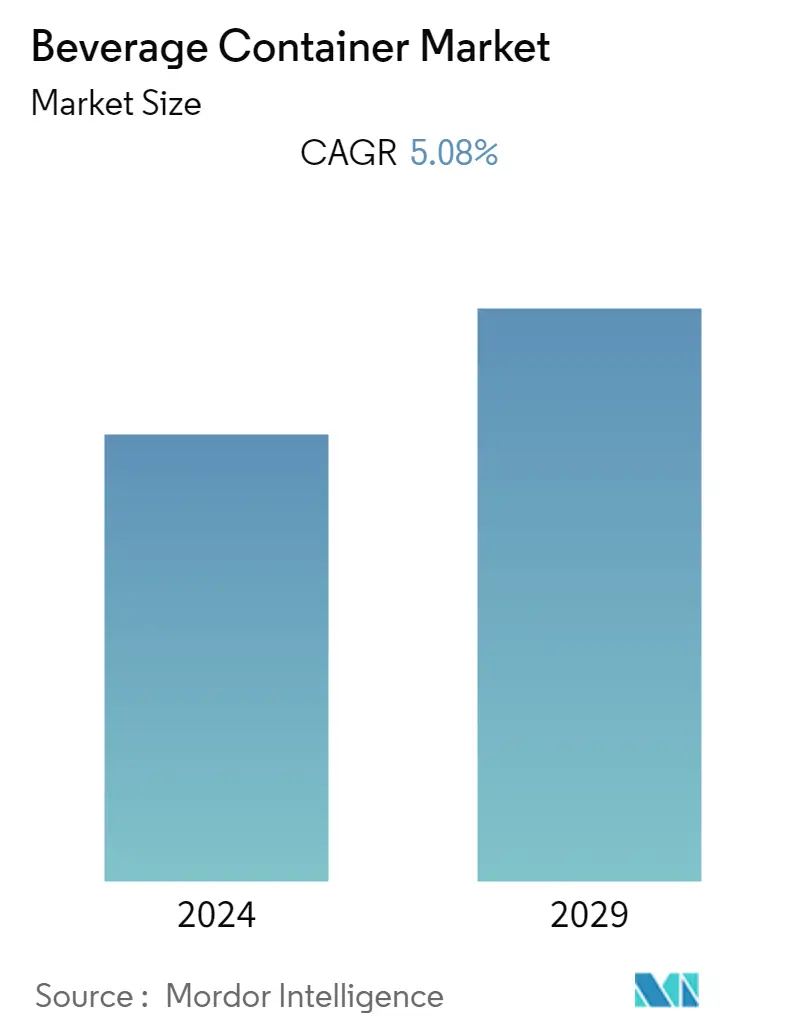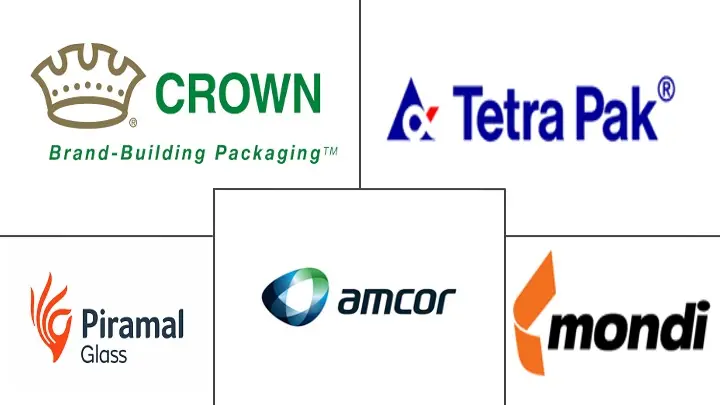Market Size of Beverage Container Industry

| Study Period | 2019 - 2029 |
| Base Year For Estimation | 2023 |
| CAGR | 5.08 % |
| Fastest Growing Market | Asia Pacific |
| Largest Market | North America |
| Market Concentration | Low |
Major Players
*Disclaimer: Major Players sorted in no particular order |
Beverage Container Market Analysis
The beverage container market was valued at USD 204.02 billion in 2020 and is expected to reach USD 283.98 billion by 2026 and grow at a CAGR of 5.08% over the forecast period (2021-2026). The growth of this market is fueled by increasing applications, technological advancements, and the growing demand in developing regions, such as the Asia-Pacific and Latin America. This growth can be attributed to rising disposable incomes, growing population, and increasing dependence on the consumption of beverages.
- Improvements in technology indicate sustainable growth in the beverage container market. The manufacturers are now able to offer similar strength with reduced thickness, weight, and material used. This enables them to provide better solutions while maintaining a lower cost. The lower price is significant because it operates in very low-profit margins of nearly 8% to 10%. For instance, glass packaging is 100% recyclable, making it a desirable packaging option from the environmental point of view. Six metric tons of recycled glass directly saves six metric tons of resources and reduces the emission of CO2 by one metric ton.
- The rising trend for reusability of beverage bottles and containers is termed as re-commerce. Re- commerce has enabled packaging players to supply their products in glass bottles. This is expected to bolster the adoption of reusable beverage bottles and containers over the forecast period. For instance, in January 2019, the launch of Loop, a durable packaging initiative run by New Jersey-based recycling company, TerraCycle, that debuted at the World Economic Forum, allows the use of steel, glass, and durable plastic reusable packaging for everyday items. The initiative enables the user to order products made by the participating companies, which are delivered in special reusable packaging, with manufacturers redesigning product containers for some of their most popular products.
- One of the significant factors driving the growth of the market is the increase in beer consumption worldwide. Beer is one of the alcoholic beverages that use glass bottles and metal cans for beverage packaging. It is packed in dark-colored glass bottles to preserve the contents, prone to spoilage when exposed to UV light. Also, the demand for various sizes of beer and benefits, like one-time consumption, make beer a preferred option for a wide range of consumers, driving the beverage container industry's growth.
- According to the US Beer Institute Annual Report, 2018, the US beer industry sells more than USD 119.3 billion in beer and malt-based beverages to US consumers each year. Moreover, according to the NBWA industry affairs, 2019, the US consumers who are 21 years and older consumed 26.5 gallons of beer and cider per person during 2018, based upon beer shipment data and the US Census population statistics. Such instances indicate that the glass containers market is poised to grow over the forecast period.
- Since the outbreak of COVID-19, countries are shifting toward single-use plastics. Supply chains are also being strained to meet the surge in demand for single-use plastic packaging. The spread of novel coronavirus did not majorly negatively affect the market, as containers support the vital food, beverage, and pharmaceutical industries that fall under essential services and cannot be discontinued until the pandemic is over.
Beverage Container Industry Segmentation
Containers made of plastic(high-density polyethylene (HDPE) polymer, polyethylene terephthalate (PET) polymers), glass, metal(alumimium, steel) and paperboard(multilayer / aseptic) that are used to protect beverage from contamination are considered in the scope.
| By Material | |||||||
| |||||||
| |||||||
| |||||||
|
| Geography | |
| North America | |
| Europe | |
| Asia-Pacific | |
| Latin America | |
| Middle East and Africa |
Beverage Container Market Size Summary
The beverage container market is experiencing significant growth, driven by increasing applications and technological advancements. The demand is particularly strong in developing regions such as Asia-Pacific and Latin America, where rising disposable incomes and population growth are contributing to higher beverage consumption. Manufacturers are leveraging technology to produce containers with similar strength but reduced thickness and weight, which helps in maintaining lower costs despite the industry's low-profit margins. The trend towards reusability, exemplified by initiatives like TerraCycle's Loop, is expected to further boost the adoption of reusable beverage containers. Additionally, the growing global consumption of beer, which is predominantly packaged in glass bottles and metal cans, is a key factor propelling market expansion.
The market is also witnessing a shift towards sustainable packaging solutions, with a notable increase in the use of recyclable PET containers. Companies like Coca-Cola and Nestle are leading the charge by incorporating recycled materials into their packaging, responding to consumer preferences for eco-friendly options. The COVID-19 pandemic has not significantly hindered the market, as beverage containers remain essential for food, beverage, and pharmaceutical industries. In North America, the demand for sustainable and innovative packaging is driving growth, with regulations encouraging the use of recycled materials. The competitive landscape is characterized by fragmented market dynamics, with manufacturers adapting to changing consumer and government expectations by diversifying their product offerings and investing in new technologies.
Beverage Container Market Size - Table of Contents
-
1. MARKET INSIGHTS
-
1.1 Market Overview
-
1.2 Industry Value Chain Analysis
-
1.3 Industry Attractiveness - Porter's Five Force Analysis
-
1.3.1 Bargaining Power of Suppliers
-
1.3.2 Bargaining Power of Buyers/Consumers
-
1.3.3 Threat of New Entrants
-
1.3.4 Threat of Substitute Products
-
1.3.5 Intensity of Competitive Rivalry
-
-
-
2. MARKET SEGMENTATION
-
2.1 By Material
-
2.1.1 Plastic
-
2.1.1.1 Water
-
2.1.1.2 Carbonated Soft Drinks
-
2.1.1.3 Fruit Beverages
-
2.1.1.4 Milk
-
2.1.1.5 Other Non-alcoholic Beverages
-
-
2.1.2 Metal
-
2.1.2.1 Carbonated Soft Drinks
-
2.1.2.2 Beer
-
2.1.2.3 Fruit Beverages
-
2.1.2.4 Ready-to-Drink tea/coffee
-
2.1.2.5 Other Non-Alcoholic Beverages
-
-
2.1.3 Glass
-
2.1.3.1 Beer
-
2.1.3.2 Wine
-
2.1.3.3 Carbonated Soft Drinks
-
2.1.3.4 Other Alcoholic Beverages
-
2.1.3.5 Other Non-alcoholic Beverages
-
-
2.1.4 Paperboard Container
-
2.1.4.1 Milk
-
2.1.4.2 Fruit Beverages
-
2.1.4.3 Other Beverages
-
-
-
2.2 Geography
-
2.2.1 North America
-
2.2.2 Europe
-
2.2.3 Asia-Pacific
-
2.2.4 Latin America
-
2.2.5 Middle East and Africa
-
-
Beverage Container Market Size FAQs
What is the current Beverage Container Market size?
The Beverage Container Market is projected to register a CAGR of 5.08% during the forecast period (2024-2029)
Who are the key players in Beverage Container Market?
Amcor Limited, Tetra Pak International S.A., Crown Holdings Incorporated, Mondi Group and Piramal Enterprises are the major companies operating in the Beverage Container Market.

